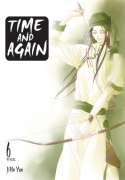 From the back cover:
From the back cover:
As war rips through the Tang Dynasty, leaving chaos and destruction in its wake, Baek-On and Ho-Yeon continue to eke out a living as traveling exorcists. While confronting vengeful grudges and putting to rest the lingering spirits of those long dead, Baek-On reflects on the tragic curse that led him to turn his back on the company of the living and follow in his father’s footsteps. While the world seems to crumble around him, Baek-On strives to keep moving forward, even if he must do so alone.
Follow Ho-Yeon and Baek-On as they journey on in the final volume of Time and Again.
Review:
I’m always a little wary of the final volume of a series I have really enjoyed. Will it disappoint? Or will it be exactly what I had hoped? Happily, volume six of Time and Again caps the series in a perfect way, which is to say “in a way that is simultaneously melancholy and hopeful.”
Baek-On has yet to recover from his crisis of self-doubt in the previous volume, in which his decision to force a man to see the truth about his inhuman wife had tragic consequences. He’s been holed up in his mother’s house for months, refusing all customers, but when a young woman arrives with a case that seems both simple and desperate, Ho-Yeon ushers her into Baek-On’s presence. Baek-On is rude at first, and it takes a threat of eviction before he actually begins to listen attentively to the girl, but he eventually goes to her home and deals compassionately with the ghost of a jilted girl who has been appearing there.
It’s clear that the words he uses when appeasing the spirit are what he would say himself to the girl in his own past—“I didn’t leave you. I’ve never left you.”—which leads to a gloriously long chapter that reveals the whole story of what happened with the girl (Wan) and why, and how it led to Baek-On being the person he is today. JiUn Yun handles this in a lovely way, because she doesn’t dwell on the pain of it all. Oh, it’s exceedingly painful for Baek-On, and awful and sad and all of those things that make for a great backstory, but it isn’t milked for melodrama. I shan’t spoil the details, but it’s this experience that motivates Baek-On to become an exorcist and to live and die alone.
The final chapter takes place after further time has elapsed. Baek-On and Ho-Yeon continue to travel together after a war has ravaged the country. Big things have happened, and yet they must continue on as usual, driving evil spirits out of children and chickens (really) and confronting the truth that animal spirits don’t seem to be all that innocent of the ways of humans. Baek-On realizes that his famous father was likely as uncertain as he is, which brings some peace, though he still intends to live his life alone and leave no descendants upon whom a spirit might inflict a grude. Ho-Yeon is also alone, having lost the last person he loved to the war, and the series ends with them pledging to carry on as they have been. Alone. And together.
Okay, yes, I totally spoiled that part, but it’s so absolutely perfect a conclusion for the series that I just had to wax rhapsodic about it. Time and Again has become one of my favorite manhwa series and, now that I know for what Baek-On has been seeking atonement all this time, I look forward to rereading it someday with the benefit of new insight.
Review copy provided by the publisher.





























Recent Comments